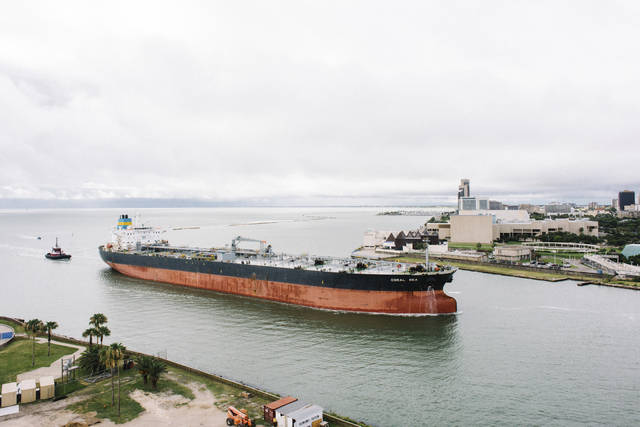New American oil tankers great for traders, lousy for owners

NEW YORK TIMES
An oil tanker arrives at the Buckeye Partners facility in Corpus Christi, Texas on June 27.
Once rare American-built oil tankers are now plentiful, changing U.S. gasoline flows and giving shipowners headaches.
These brand-new tankers have names like American Endurance, American Freedom, American Liberty and American Pride painted on their sterns. They’re part of a growing fleet of so-called Jones Act ships, named for a law almost a century old that mandates any commodities moved from one U.S. port to another are hauled by vessels manufactured in an American shipyard.
Government data show that in May, U.S.-made tankers had their best month ever transporting gasoline components from the Gulf Coast’s refinery row to Florida and other East Coast ports. The flood of new tankers means that even as the ships are at their busiest, hauling about 16 million gallons a day of products that do things like boost octane in gasoline, the owners of the tankers aren’t collecting bigger profits.
There are now about 94 active Jones Act vessels sailing around the U.S., up almost 10 percent since December, according to Overseas Shipholding Group, Inc., a company that owns a quarter of the total fleet. With more vessels to go around the marketplace, shippers aren’t willing to pay for long-term commitments.
OSG is seeing once committed charterers walking away from extended contracts to cheaper short-term rates. Its chargeable time on spot voyages versus time charters doubled this year as spot rates slumped 31 percent to $18,288 a day in the second quarter versus a year earlier, OSG said in a filing.
“If you see more stuff on spot, that favors the charterers,” said Barry Parker, a maritime consultant with Bdp1 Consulting Ltd. “In a perfect world for them, they wouldn’t commit to anything.”
Don't miss out on what's happening!
Stay in touch with breaking news, as it happens, conveniently in your email inbox. It's FREE!
As the cost to charter the Jones Act ships falls, supply flows are changing for both refined products and crude oil. In the past nine years, Gulf Coast-to-East Coast shipments of U.S.-manufactured gasoline blending components have soared from no deliveries at all to a record 388,000 barrels a day, outpacing imports from abroad by 10 percent.
The glut of product tankers is being exacerbated by a lack of economical routes for crude shipments. Two-thirds of the 29 spot fixtures done for ocean-going Jones Act tankers in the second quarter were for products service, said Samuel H. Norton, OSG chief executive, on the company’s second-quarter earnings call.
In the nascent days of the U.S. shale revolution, producers in Texas had to sell their crude at deep discounts due to limits on exports and a lack of pipelines to refineries near Houston and New Orleans. One solution was to find a Jones Act ship to move the oil to refineries in places like Philadelphia. A dearth of available tankers stimulated interest in American shipbuilding.
Then, a 40 year-old law that banned most American crude exports was lifted at the end of 2015. As the export rules were loosened and pipelines to Gulf Coast refineries came online, crude demand for Jones Act tankers softened and the vessels flipped to refined products service.
That influx of vessels shipping gasoline has pushed down rates to the point where tankers are competing with pipelines for the biggest route: Gulf Coast to East Coast. The country’s largest gasoline conduit, the Colonial Pipeline, had less demand than capacity for the first time in six years this summer, partly because of the increased tanker shipments.
EAST COAST
Some East Coast refiners are still using American tankers to bring in domestic crude. One example is the Overseas Texas City, a tanker that can haul about 300,000 barrels. This year, it has shuttled back and forth from Gulf Coast storage hubs to Phillips 66’s Bayway refinery in New Jersey three times, and once to Delta Air Lines Inc.’s Trainer refinery near Philadelphia.
At any time, we may have several ships on charter for various periods and with various Jones Act owner/operators for this service, Dennis Nuss, spokesman for Phillips 66, said in an email. Phillips 66 “uses them primarily to deliver Gulf Coast domestic crude to our Gulf Coast and Bayway refineries,” he said.
Some ships may end up shifting back to crude service. As inland crude production becomes connected to the Gulf Coast via new pipelines like the Dakota Access, oil is draining to the Gulf of Mexico and providing pressure on U.S. benchmark West Texas Intermediate crude relative to Brent, the international marker, according to Norton.
“If that spread widens, then the feedstock procurement decision of Philadelphia refineries in particular is redirected,” he said by phone. A wider spread is key to the “reemergence of crude transport demand for Jones Act tonnage,” he said. That spread is indeed widening near a two-year high, settling at $3.33 a barrel Wednesday.
Some transport companies are on both sides of the pipeline/tanker divide. Kinder Morgan Inc. has its toes dipped in both markets, and has reaped a 1 percent increase in terminal earnings as a result.
“The product tankers’ key benefit over pipelines is their flexibility,” said John Schlosser, Kinder Morgan’s terminals president in Houston. “Tankers can be repositioned to load or unload at various ports in response to changing market conditions.”



